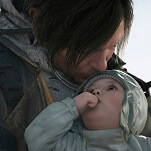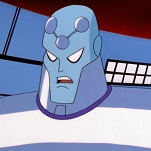Sonic Adventure 2’s ranking system has largely endured in 3D Sonic ever since its introduction, even appearing in 2D in the Sonic Rush duology on DS, making some sort of pursuit of perfection a constant in the series. But part of the beauty of a ranking system is that it’s very malleable—if you alter the way point rewards for different actions are weighted, you create a different gameplay experience. If every subsequent entry in the series was just Sonic Adventure 2 again, that’d be fine—it is great, after all—but one of the things that makes coming back to so many different games in the series so captivating is that each one brings with it little tweaks to what its version of perfection looks like while still keeping that core pursuit intact.
For example, Sonic Adventure 2, as already explained, has a ranking system that prioritizes speedy completion of skillful actions, encouraging you to balance speeding through the level and carefully engaging with its many obstacles. Other games in the series, though, lean their weight more heavily into one side or the other of this balance. In Sonic Colors, the point value assigned to completion time is drastically decreased, and the levels are designed in a way that emphasizes methodical, exploratory, and technical gameplay a lot more. Grinding for ranks in Colors is therefore an experience about learning the layouts of levels in order to efficiently collect rings and other collectibles while creatively using wisp powers to rack up a high score. It plays very differently from the high-octane adrenaline rush of Adventure 2, but it still maintains the satisfying feeling of constant improvement. On the opposite end of the spectrum, Sonic Generations has ranks assigned almost entirely based on completion time, and then gives additional challenges with even more demanding time trials. Generations is the speedgame among speedgames, eschewing even the technical aspects of Adventure 2 in favor of levels meant to be blazed through and conquered in as short a time as possible. In practice, the experience of playing each of these three games is very different, but they all scratch that same itch, and the fact that there are so many different variations on how to scratch it keeps the series endlessly interesting.
If this style of gameplay is something that works for you, like it does for me, it can make it easy to look past the flaws that, for many people, drag the experience down. Sure, Sonic Unleashed is filled with overlong pace-killing beat-em-up sections, but if you push through those, you get more amazing speed levels to replay to your heart’s content. Sure, Sonic Frontiers could be a lot smoother, but with the right attitude, that dodginess is just another thing to learn to work around as you sharpen your skills. And hey, this is probably the most controversial one but I’m gonna say it anyway: sure, the infamous Sonic the Hedgehog (2006) may be an unfinished, barely playable mess, but deep down under all that baggage is an approach to level and game design that is truly inspired—and if you need proof of that, just try out Project ‘06, a fanmade remake that polishes it up and makes it into the wonderful gem that it was always meant to be.
And I think that really speaks better than anything to how strong the pull of this gameplay is; it inspires passion enough for a dedicated fan to pour tons of effort into remaking what was widely considered upon release to be one of the worst games of all time just to unlock its full potential. Sonic provides an experience that very few other games do—for a long time, it was pretty much the source for this kind of gameplay, with the very occasional release of games like Mirror’s Edge notwithstanding. Even now, as recent indie darlings like Neon White and Pizza Tower finally start to recapture the same appeal, they wear their Sonic influence on their sleeves.
Spectacle: Rolling Around At the Speed of Sound
The primary emotional response 3D Sonic games are trying to instill in the player is a power trip, but not in the same way as something like DOOM. DOOM wants to make you feel like an unstoppable killing machine, ripping and tearing your way through Hell, while Sonic wants you to feel like a speed demon, the fastest thing alive, an unstoppable force of nature barreling through the world with a rhythm and momentum that makes every action flow into the next like water.
This emotional response differentiates Sonic from contemporaries like Mirror’s Edge, a game which, while having a very similar gameplay loop and general approach to game design, feels totally different to play. Faith is ultimately just a human—a highly skilled human, but a human nonetheless—bound by human restrictions into at least somewhat realistic movement. You jump between believable buildings and rooftops, taking impressive but ultimately realistic leaps of faith.
Sonic is all about the spectacle; it’s over-the-top, absurd, and extremely anime. Just look at Sonic Adventure 2’s City Escape, probably the most iconic 3D level in the franchise. You use the broken door of a military helicopter you just escaped from as a skateboard to grind down the sloping streets of totally-not-San Francisco while fighting robot mechs deployed by totally-not-the U.S. military and doing tricks off of conspicuous orange ramps, ending the level off with a mad chase away from a giant truck the size of the entire street, both lanes. Subtlety, reservation, calm; these words are not in Sonic’s vocabulary. It is all spectacle, all the time.
This is another core appeal of the series, in my opinion. It’s not just about going fast and getting faster, it’s about what you’re doing fast, where you’re doing it, how bonkers it is. Sure, you could play Mirror’s Edge or Neon White, but do those games let you dash up an Italian clock tower only to descend from its pinnacle onto a vista of hot air balloons? Do they have you infiltrating a mining facility on an alien planet, transforming into a rocket to blast through the metal structures as piano music serenades you in the background? Do they find you slicing through the rolling fields and rotting ruins of a long-forgotten island civilization as you chase after that giant robot you saw in the distance? This is another big part of why I keep coming back to Sonic in particular even after having played and loved other games with similar gameplay appeal: despite what some cold-hearted cynics might try to tell you, Sonic’s cool factor is off the charts.
Of course, when talking about the cool factor, I’d be remiss not to bring up these games’ soundtracks. The music is probably the one universally praised thing about 3D Sonic, something even people who actively loathe this side of the series overall can probably admit they enjoy. Every game in the series is fueled by incredible, high-octane, high-energy bangers, whether that be the hard rock of Shadow the Hedgehog, the bumpin’ techno of Sonic Forces, or the mix of styles you can find in Sonic Adventure 2. The crown jewels of these soundtracks, of course, are the vocal tracks, with each 3D game (except Sonic Lost World) including at least one epic lyrical piece. With sick guitar solos, infectious earnesty, and lyrics which are every bit as memorably badass as they are totally cringe, these songs, like “Live and Learn,” “Knight of the Wind,” and Frontiers’ “Undefeatable,” have burned themselves into my brain and shredded their way into my heart, to the point that I’m only slightly ashamed to admit that Sonic Adventure lead composer Jun Senoue’s band Crush 40 is unironically among my most-listened-to bands.
Heart: Live and Learn
There’s one more aspect to explore about what makes this series so compelling. If people were just in love with the gameplay or the spectacle or the music, that’d be one thing. But it’s more than that: the character of Sonic himself, and to a lesser extent his friends, is clearly captivating in some way. Mario, Crash Bandicoot, and Spyro are all fun platforming mascots with cool gameplay and spectacle as well, but none of these characters inspire the same fandom as Sonic does. Sonic fans have somewhat of a reputation for producing huge amounts of fanart and fanfiction surrounding the character, often with a level of earnestness and gravitas that seems entirely unbefitting of a silly blue hedgehog. And on the flip side, he has undeniably baked himself into meme culture, especially on what one could call the more left-leaning side of the internet. Scroll for long enough on Twitter and you’ll see Sonic telling TERFs to shut up, advocating for unionization, and asking game companies to pay their employees more to work less. And it’s worth noting that this treatment largely applies to the Sonic that we know from the 3D games—the Sonic from the Genesis games is pretty much an entirely separate, and less popular, character—so much so that Sonic Generations and Forces actually canonically made Classic Sonic into a distinct entity. This raises the question: where does this appeal come from, and why Sonic and not others?
Well, one thing separating Sonic from other platforming mascots is that he is actually a robust character. To use the three points of comparison from earlier, Mario is pretty much a blank slate for the player to imprint onto, his whole personality distilling down to “wahoo!” Crash Bandicoot is just a lovably dumb goofball with nothing really going on deeper than that. And while Spyro is definitely more of an actual character, he’s just fairly bland and generic in his personality, the basic archetype for “young, somewhat cocky hero.” Sonic has way more to him than this, in no small part thanks to the fact that his games tend to feature more in-depth narratives with cutscenes, and the fact that he’s gotten years of TV shows, comics, and most recently movies to flesh him out. Now, this isn’t to say that Sonic is the most complex or fleshed-out character in the world, but he is a fleshed-out character, which can’t be said of most of his peers.
So what exactly is that character? Sonic is a fun-loving adventurer with a carefree approach to living his life. His theme song in Sonic Adventure, “It Doesn’t Matter,” introduces him like this:
“Well I don’t show off, don’t criticize. I’m just living by my own feelings. And I won’t give in, won’t compromise! I just only have a steadfast heart of gold!”
And the big hook of the song is “It doesn’t matter now what happens, I will never give up the fight! There is no way I will run away from all of my frights!”
He’s self-motivated, a bit cocky, and entirely uncompromising in his sense of justice. Consistent across all of his appearances is this balance between approaching life with carefree fun as his number one goal, but always standing up against injustice whenever he sees it. He does no harm, but he takes no shit.
This is important to how he relates to other characters in the series as well. With friends, his confidence makes him a person who can help inspire others to live their lives in a more joyful way by modeling it to them, whether that be by helping Sonic 06’s Princess Elise to learn to cut loose or showing the player character in The Murder of Sonic the Hedgehog that they’re more capable than they ever imagined. And with foes, while he has zero tolerance for injustice or causing people harm, he still has a way of seeing the best in people in spite of the harm they’ve caused, whether that be with Shadow in Sonic Adventure 2, Merlina in Sonic and the Black Knight, or Sage in Sonic Frontiers.
With this character in mind, coupled with his aggressively ‘90s snark, Sonic’s position in internet culture starts to become more clear. It’s no surprise to see the memeing left latch onto him—he has counted evil technocrats and loose analogs for the U.S. military as some of his more consistent enemies, encouraging others towards self-acceptance is one of his biggest things, and his wholeheartedly cringe style of humor is just begging to be memed. And as for spawning the more earnest side of the fandom, I think it makes sense too. Sonic is a rare example of a childhood videogame character who is an actual character, and he’s just the type of guy that feels safe and trustworthy, and is just fun to write. Playing through this year’s The Murder of Sonic the Hedgehog really emphasized for me how easy it is to become endeared to this hedgehog and his cast of eclectic friends, especially in the rare situation that they are blessed with good writing in an official work. It’s just very wholesome.
Conclusion: Live Life
The 3D Sonic games have caught a lot of flak over the years, and a lot of it has been deserved. Sega continues to mismanage the hell out of this series, pumping out unfinished game after unfinished game and continually coming up short of the series’ potential. A lot of people have understandably been burned by this and want nothing to do with this side of the series, and I can hardly blame them considering everything.
But I’ll keep coming back. Childish as this series is, I’ve actually grown to love it much more as an adult than I ever did as a kid. What it offers can’t easily be found anywhere else, and while it may trip over itself in execution due to an endlessly frustrating parent company, there’s an undeniable heart at the core of this series that I for one can’t get enough of. The 3D Sonic games may never be as polished or as iconic as the Genesis classics, and that’s okay, but I hope I’ve at least explained why they speak a bit more to me and so many others.







































